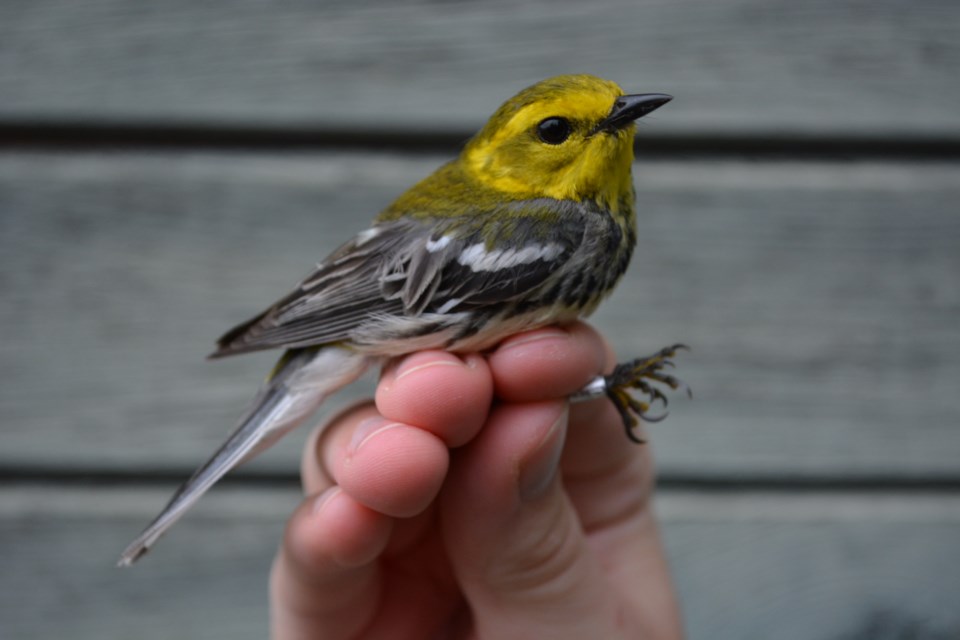Located at the tip of Sibley Peninsula, the Thunder Cape Bird Observatory has been banding migratory birds for most of its 30-year history. Due to the pandemic, the observatory missed the spring migration and operated with a skeleton staff for the fall migration for the past couple of years.
Rinchen Boardman has been program coordinator and bander-in-chief at the observatory since 2014. He has worked at numerous bird observatories and banding stations across Canada, and even as far away as Scotland.
By late April, Boardman is at the observatory preparing for opening on May 1. The spring migration is more intense than the fall migration, he explains. “Spring season is only about 6-7 weeks, because the birds are driven to procreate. So they’re up here fast, coming up from South America, Central America and other places. They get up here fast, find a mate, lay some eggs, raise their young and eat our fantastic insects and seeds that we have up here.”
This year, banding will wrap up by June 6, and start again on Aug. 1 for the fall migration. Birds are in less of a hurry in the fall, so the station continues operating until the end of October.
Part of Boardman’s job is finding volunteers. “Without volunteers, the station wouldn’t exist,” he acknowledges. “Many volunteers don’t have much experience handling small wildlife, so that’s part of my job,” he adds. The hands-on training attracts many of the applicants.
Most are young people; students who are working for their bachelor’s or master’s, or are in-between degrees. Many are in the fields of wildlife management, natural history or biology, and they come to learn skills that can help them further their careers. There have also been a few retired people, Boardman says. “We’ve had a retired dentist, and one was a musician.”
The observatory can house up to six volunteers at a time. Surprisingly, very few come from Thunder Bay. Some have come from as far away as New Zealand, Germany and Cuba. “Maybe the grass is greener the further away it is,” Boardman muses.
“Sometimes volunteers ask how many days a week will we work. I say a migrating songbird doesn’t know if it’s a Wednesday or Sunday. So we work nonstop from the second we get there,” he says. “Our day runs for seven hours, starting half an hour before sunrise.”
Passerines (songbirds) fly into a mist net and fall into a pocket. Volunteers get to the birds as quickly as they can, to identify, weigh and measure them. The birds are then fitted with a tiny metal band with a unique nine-digit number. The banding data is entered into Environment Canada’s Bird Banding Office, and anyone can access the data for research purposes.
Observation data is compiled through Birds Canada, which has statisticians who look at all of the data to make comparisons and determine fluctuations of populations, increases and declines in species’ populations, and correlate bird traffic with meteorological data.
Once in a blue moon, the team might capture a bird that has already been banded and entered into the system. “With small passerines, it’s one in 600 or 700,” Boardman says. “In the autumn we get a much higher encounter rate; maybe one in 100, with larger birds like blue jays and sharp-shinned hawks, and Northern Saw-whet owls.”
“I’m absolutely excited to be back; a lot of birds are just changing into their very vibrant colours,” Boardman says. Although visitors won’t be allowed inside the lab this year, they are still very welcome on-site, he says. It’s a 13 kilometre hike from the Kabeyun Trail Head, but the last few kilometres are very rocky and challenging. “A lot of people bike and hike; that’s the fast way,” he says. “And we have a campsite out here.”
The Thunder Cape Bird Observatory is a place where you can witness the awe-inspiring phenomenon of bird migration. “It’s witnessing something that’s greater than us human beings,” Boardman says, “witnessing migration - literally rivers of birds, at certain times of the year.”



